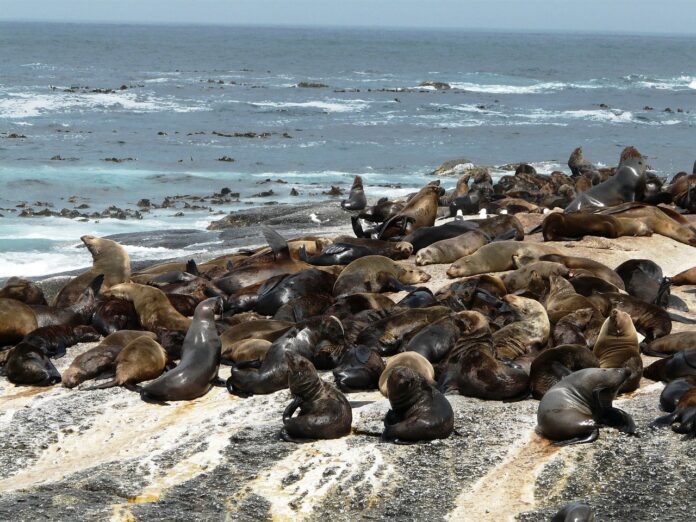In 1741, the expedition of V. Bering stumbled upon a herd of strange pinniped mammals. The animals occupied almost the entire coastline of the Commander Islands. The colony was quite noisy, consisting of several tens of thousands of individuals. Large males were aggressive toward each other but completely indifferent to humans. This was the first encounter between naturalists and fur seals (Latin name – Arctocephalinae).
In fact, these creatures have no relation to the cat family, as one might assume from their name. The only feature they share with cats is their sensitive long whiskers, which help them navigate their surroundings. In all other respects, fur seals are more similar to seals, their closest relatives.
Description
Fur seals are medium to large animals, adapted to life both in water and on land. They have streamlined, elongated bodies and four flexible flippers, allowing them to maneuver in the sea and serve as stable support on the shore. Their small heads rest on strong, flexible necks, giving them excellent mobility. These aquatic creatures have external ears, giving them well-developed hearing and echolocation abilities. However, they suffer from poor eyesight; although their sharp-nosed faces are adorned with large, dark eyes, their vision is weak since it’s not crucial underwater.
A unique species feature is their small tail, which is barely noticeable unless closely examined. Fur seals have short, dense fur, usually black or brown, which helps them survive in cold, food-rich waters. However, this soft, fluffy coat has made them targets for poachers. Illegal hunting primarily focuses on the pups, as their wool is considered more valuable. Additionally, the meat of young seals can be used as food. This barbaric practice has pushed some subspecies of seals to the brink of extinction, with several now listed in the Red Data Book.
Male fur seals are easily distinguishable from females. The average weight of a female is 40-70 kg, while males can weigh 250-300 kg. Females are four times smaller in size, but their numbers in the herd are much greater. As a result, mating systems are organized into harems, with the strongest males claiming the most females.
Habitat
Fur seals live in the waters of the Pacific Ocean, from Alaska’s coast to southern Australia. Most of them prefer the subarctic zone, though one species is found along the coast of Namibia, in Africa. Pinnipeds do not settle in inland water bodies. They prefer rocky areas, but they can also be found along gentle shores. Land is merely a resting place for fur seals, while their primary activity is underwater hunting for fish and cephalopods. On this “diet,” they build up a layer of fat over the summer, preparing for migration northward.
During the breeding season, fur seals are forced to migrate to the Commander Islands or the Kuril chain, where colder waters and abundant food are available for the pups. Observations show that fur seals tend to stick to their habitual migration routes, with tagged females often returning to the same rocks for their colonies season after season.
Interesting Facts About Fur Seals
- There are over 5 million fur seals worldwide.
- Another less common name for fur seals is “eared seals.”
- The largest colony is located in the Bering Sea, Russia.
- Fur seals live in herds but never hunt together. Each individual catches its own food.
- They can dive to depths of up to 60 meters in search of food and stay underwater for up to 10 minutes.
- Fur seals are clumsy on land but fast and agile in the water, swimming at speeds up to 27 km/h, similar to a motorboat.
- They can sleep in the water by stretching out three limbs while instinctively paddling with the fourth.
- Eared seals recognize each other by both scent and voice.
- In 99% of cases, a female gives birth to only one pup at a time.
- Female fur seals have an extremely strong maternal instinct, but males are poor fathers, sometimes crushing their pups if they get in their way.
- As they age, fur seals, like humans, develop gray hair.
- In captivity, fur seals can live up to 30 years, while more than half of those in the wild die by age 2-3.
- Scientists believe fur seals have a higher level of intelligence than many other animals.
- These animals never get cold, thanks not only to their fat layer but also to tiny air bubbles that form under each hair, creating an insulating barrier.
- Fur seals can be born albino, though all documented cases of this mutation have been in pups.
Fur seals play a crucial role in the food chain, consuming large amounts of fish and mollusks. An adult male’s stomach can digest up to 16 kg of food in one sitting. In turn, orcas, sharks, and other marine predators hunt fur seals. In these cases, the only way for fur seals to survive is to outrun their predators and reach land.
However, it’s not their natural enemies that pose the greatest threat to their population—humans do. Global warming and ocean pollution are rapidly diminishing the number of resting and hunting grounds available to these animals.
